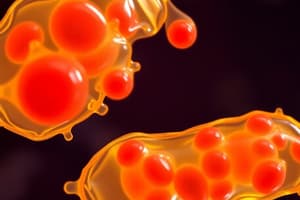Podcast
Questions and Answers
What happens during the spindle checkpoint?
What happens during the spindle checkpoint?
- New nuclei begin to form.
- Sister chromatids separate from each other.
- The cell checks if all chromosomes are correctly attached. (correct)
- Chromosomes align at the metaphase plate.
How do microtubules contribute to the stability of the spindle?
How do microtubules contribute to the stability of the spindle?
- They form the membrane around the nucleus.
- They attach to chromosomes from the same pole.
- They grab on to microtubules from the opposite pole. (correct)
- They pull chromosomes apart.
What is the role of motor proteins during mitosis?
What is the role of motor proteins during mitosis?
- To initiate cytokinesis by forming the cell membrane.
- To break down the mitotic spindle.
- To walk along microtubules and carry chromosomes or other microtubules. (correct)
- To help chromosomes align at the metaphase plate.
What occurs in anaphase?
What occurs in anaphase?
Which event signifies the start of cytokinesis?
Which event signifies the start of cytokinesis?
What happens during telophase?
What happens during telophase?
What best defines the metaphase plate?
What best defines the metaphase plate?
How is the mitotic spindle disassembled during telophase?
How is the mitotic spindle disassembled during telophase?
What characterizes the internal environment of lysosomes?
What characterizes the internal environment of lysosomes?
Which organelle is primarily responsible for organizing microtubules?
Which organelle is primarily responsible for organizing microtubules?
What is a primary function of vacuoles in plant cells?
What is a primary function of vacuoles in plant cells?
During which phase of mitosis do chromosomes line up at the metaphase plate?
During which phase of mitosis do chromosomes line up at the metaphase plate?
Which best describes the main function of centrioles in relation to cilia and flagella?
Which best describes the main function of centrioles in relation to cilia and flagella?
What occurs during the anaphase stage of mitosis?
What occurs during the anaphase stage of mitosis?
Which of the following is NOT a characteristic of lysosomes?
Which of the following is NOT a characteristic of lysosomes?
What is the primary purpose of the mitotic spindle during mitosis?
What is the primary purpose of the mitotic spindle during mitosis?
What key process occurs during cytokinesis?
What key process occurs during cytokinesis?
Which structure is essential for organizing chromosomes during mitosis?
Which structure is essential for organizing chromosomes during mitosis?
During which phase do chromosomes become more condensed and the nuclear envelope breaks down?
During which phase do chromosomes become more condensed and the nuclear envelope breaks down?
What happens to the nucleolus during prophase?
What happens to the nucleolus during prophase?
What are sister chromatids connected by?
What are sister chromatids connected by?
Which of the following structures begins to form in early prophase?
Which of the following structures begins to form in early prophase?
What are microtubules that bind to chromosomes during mitosis called?
What are microtubules that bind to chromosomes during mitosis called?
What primarily occurs at the checkpoints during mitosis?
What primarily occurs at the checkpoints during mitosis?
Flashcards
Cytokinesis
Cytokinesis
The process of a cell dividing into two daughter cells.
Mitosis Checkpoints
Mitosis Checkpoints
Control points in the cell cycle that ensures mitosis proceeds correctly; failure in these lead to issues like cancer.
Interphase (late G2)
Interphase (late G2)
The stage before mitosis, where the cell copies its DNA into sister chromatids.
Sister Chromatids
Sister Chromatids
Signup and view all the flashcards
Centrosome
Centrosome
Signup and view all the flashcards
Early Prophase
Early Prophase
Signup and view all the flashcards
Mitotic Spindle
Mitotic Spindle
Signup and view all the flashcards
Microtubules
Microtubules
Signup and view all the flashcards
Prometaphase (Late Prophase)
Prometaphase (Late Prophase)
Signup and view all the flashcards
Kinetochore
Kinetochore
Signup and view all the flashcards
Centromere
Centromere
Signup and view all the flashcards
Kinetochore Microtubules
Kinetochore Microtubules
Signup and view all the flashcards
Microtubules (non-kinetochore)
Microtubules (non-kinetochore)
Signup and view all the flashcards
Aster
Aster
Signup and view all the flashcards
Metaphase Plate
Metaphase Plate
Signup and view all the flashcards
Spindle Checkpoint
Spindle Checkpoint
Signup and view all the flashcards
Anaphase
Anaphase
Signup and view all the flashcards
Motor Proteins
Motor Proteins
Signup and view all the flashcards
Telophase
Telophase
Signup and view all the flashcards
Cytokinesis
Cytokinesis
Signup and view all the flashcards
Lysosomes
Lysosomes
Signup and view all the flashcards
Vacuoles
Vacuoles
Signup and view all the flashcards
Centrosome function
Centrosome function
Signup and view all the flashcards
Mitosis
Mitosis
Signup and view all the flashcards
Mitosis steps
Mitosis steps
Signup and view all the flashcards
Interphase
Interphase
Signup and view all the flashcards
Prophase
Prophase
Signup and view all the flashcards
Metaphase
Metaphase
Signup and view all the flashcards
Anaphase
Anaphase
Signup and view all the flashcards
Telophase
Telophase
Signup and view all the flashcards
Study Notes
Unit II - Lecture 8
- This lecture covers fundamental life sciences topics, crucial for quizzes and tests.
- All slides are important for assessment.
Lysosome
- Specialized membrane-bound vesicles, primarily in animal cells.
- Contain hydrolytic enzymes to break down biomolecules.
- Structurally, dense granular, enclosed by a lipid bilayer.
- Internal environment has an acidic pH (4.5-5.0), optimal for enzymes.
- Autophagy: degrades worn-out cellular components.
- Endocytosis: degrades extracellular substances engulfed by the cell.
- Exocytosis: expels enzymes, aids in breaking down extracellular material.
- Often involved in white blood cell function.
Lysosome Enzymes
- Lysosomes contain numerous hydrolases (enzymes).
- Approximately 40 distinct varieties, categorized by substrates.
- Proteases: hydrolyze proteins, creating amino acids.
- Lipases: hydrolyze fats into fatty acids and glycerol.
- Amylases: hydrolyze carbohydrates into simpler sugars.
- Nucleases: hydrolyze nucleic acids (DNA/RNA).
- Phosphoric Acid Monoesters: hydrolyze phosphoric acid esters.
Why Lysosomes are Known as Suicidal Bags
- Lysosomes have a potent arsenal of hydrolytic enzymes.
- Primary function: degrade/recycle cellular components (extraneous or aged).
- Vulnerability: Enzymes can rupture lysosomes, releasing them into cytoplasm, damaging the cell (autolysis).
- Important for cellular health/waste removal, but poses risk of cell self-destruction.
Vacuoles
- Membrane-bound organelles, in plants, fungi, some protists, animals, and bacteria.
- Compartments containing water, inorganic/organic molecules, and enzymes.
- Functions:
- Isolating harmful materials.
- Containing waste/small molecules/water (especially in plants).
- Maintaining turgor pressure (shape/buoyancy for plants).
- Maintaining an acidic internal pH.
- Exporting unwanted substances.
- Supporting plant structures (leaves/flowers).
- Storing proteins needed for germination in seeds.
Centrosome and Centriole
- Centrosome: Organelle containing two centrioles.
- Centrioles: Membraneless cylindrical structures.
- Surrounded by amorphous pericentriolar material (centrosphere/kinoplasm/cytocentrum).
- Commonly called "diplosomes."
- No internal compartment.
- Found in animal cells, except amoeba.
- Absent in higher plants, but found in some stages of certain plants' life cycles.
Centriole Function
- Involved in cell division (mitosis and meiosis).
- Help organize microtubules.
- Involved in the positioning of microtubules.
- Can transform into basal bodies (forming cilia/flagella).
Chromosomes
- 23 pairs
- One from each parent
- Same length, same genes in the same position
- Chromosomes from father & mother are designated
Homologous Chromosomes
- Chromosomes having similar structures
- Same length.
- Same genes.
- Same position.
Alleles
- Specific form of a gene.
- Responsible for variations in expressed genes.
- Occur in pairs.
Mutations and Allele Frequencies
- Mutations in genes can create new phenotypes (like different eye colors).
- Allele frequency shifts over time, but some alleles remain dominant.
Cell Division (Mitosis)
- Stages: Interphase, Prophase, Metaphase, Anaphase, Telophase, Cytokinesis.
- Process where somatic cells divide to produce two genetically identical diploid cells.
- Chromosome number remains the same.
Cell Division (Meiosis)
- Process where sex cells divide to produce four genetically unique haploid gametes or cells.
- Chromosome number is halved.
- Stages: Prophase I, Metaphase I, Anaphase I, Telophase I, Prophase II, Metaphase II, Anaphase II, Telophase II, and Cytokinesis.
Studying That Suits You
Use AI to generate personalized quizzes and flashcards to suit your learning preferences.




